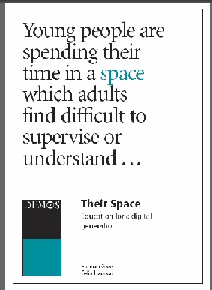What does the latest research from Besa tell us about who schools listen to when it comes to ed tech product recommendations?
Read MoreReview of Amazon Prime
I thought I'd review Amazon Prime today because there are quite a few substantial discounts for members for today only. For example, something I've been cogitating on for a while has nearly 20% off today. I've only talked about the UK site in this article.
Read MoreWhat I'm reading: Bounce
What does it take to become an expert? And what can the Computing teacher do about it?
Read MoreWhat I've been reading: Computers, they drive us crazy!
It probably won't have you clutching your sides and gasping for breath, but may bring a smile to your face.
I don't need any excuse to leap into the nearestsecond-hand bookshop when I'm out and about, but if I were forced to provide one, it would be this. You occasionally come across some real gems.
My latest find is “Computers: they drive us crazy!”, by Helen Exley and Bill Stott. Having been published in 2007, this now officially counts as an ancient document. You can try purchasing a new copy from Amazon, if you're prepared to wait until the book is in stock, which could be never. Alternatively, you could pay anything from a penny to almost £800 to receive it very soon if your idea of deferred gratification is having to wait for the tea to brew.
Because of the difficulty of acquiring this book I thought more than twice about writing a review of it. So regard this as an exhortation to visit used book stores and a plea to give cartoon books like this a second glance.
It's a slim volume, consisting solely of wry comments on technology in the form of cartoons. It's thin enough to get through in a single sitting, and while the jokes won't have you visiting hospital with cracked ribs, they will probably bring a smile to your face.
These comments pertain to this particular book, of course, but I think they probably apply to many if not all such books.
Are they good value for money, these books? Strictly speaking, not really. At least, I tend not to buy such things for myself. On the other hand, as a small gift for the geek in your life, or a little extra on top of their main present from you, a book like this can be a nice touch.
Here's the link to this particular book on Amazon, just in case you can find a decently-priced used copy: Computers: They drive us crazy!
Review of Thinking Allowed on Schooling
Thinking Allowed is a godsend to all those people in education who think that many of the policies and ways of doing things don't really work, but are not really in a position to say so.
Read MoreYou could let Grammarly take some of the strain of proofreading. Photo by Pink Sherbert Photography https://www.flickr.com/photos/pinksherbet/
Review of Grammarly -- and a competition
Read about a proofreading tool that works on the web -- and maybe win a free subscription.
Read MoreAda's Algorithm
Review of Ada's Algorithm: How Lord Byron's Daughter Ada Lovelace Launched the Digital Age
Ada's Algorithm goes into minute detail about Ada Lovelace's life, and her influence on the development of Computer Science.
Read MoreR is for … Reviewing
 For a long time I have tried to refrain from writing negative reviews. My thinking has been that it’s nicer to be nice than to be nasty. I don’t like to hurt anyone’s feelings, and rather than send some poor author or software developer into a tailspin of depression, I’ve often decided to simply not give the product any publicity.
For a long time I have tried to refrain from writing negative reviews. My thinking has been that it’s nicer to be nice than to be nasty. I don’t like to hurt anyone’s feelings, and rather than send some poor author or software developer into a tailspin of depression, I’ve often decided to simply not give the product any publicity.Blog Review: nhowie
 I’ve been thinking for some time that I really ought to write an article every so often about blogs I like reading, or that have recently sprung up or come to my attention. I thought I’d get the ball rolling with “nhowie: Musing mainly about ICT in K-12 education”.
I’ve been thinking for some time that I really ought to write an article every so often about blogs I like reading, or that have recently sprung up or come to my attention. I thought I’d get the ball rolling with “nhowie: Musing mainly about ICT in K-12 education”.Computers in Classrooms, new issue
 Today I have been working on the new issue of Computers in Classrooms, the free e-newsletter for those with a professional interest in educational ICT. Here’s a summary of what it contains. It will be published later today.
Today I have been working on the new issue of Computers in Classrooms, the free e-newsletter for those with a professional interest in educational ICT. Here’s a summary of what it contains. It will be published later today.
A Teen's View of "Their Space" and Internet Safety
 In 2007, the British think tank, Demos, published its report entitled “Their Space”. According to the authors,
In 2007, the British think tank, Demos, published its report entitled “Their Space”. According to the authors,
This report is the result of nine months of work that focused specifically on understanding how children and young people use new technologies.
The review below was written soon after its publication, by Sarah Hillier, who was at that time a teenager. I’ve just re-read her article, and I think its observations and incisiveness – not to mention the beauty of her writing – have stood the test of time. The article which follows has only been modified slightly from the original. I hope you enjoy it.
Review of 30 Day Blogging Challenge
 If you're looking for a handy, no frills book of suggestions for blogging, this book should meet your requirements. Having been designed as an email course, 30 Day Blogging Challenge, written by Nikki Pilkington, consists mainly of 30 very short articles on different aspects of blogging. Being able to buy the whole lot in the form of a book is excellent for those of us for whom deferred gratification is an alien concept.
If you're looking for a handy, no frills book of suggestions for blogging, this book should meet your requirements. Having been designed as an email course, 30 Day Blogging Challenge, written by Nikki Pilkington, consists mainly of 30 very short articles on different aspects of blogging. Being able to buy the whole lot in the form of a book is excellent for those of us for whom deferred gratification is an alien concept.
Review of Problogger’s Guide To Blogging For Your Business
 Before looking at the book, written by Mark Hayward, in detail, it’s worth pointing out what the book is, and is not. It is, as the title implies, concerned with blogging in order to promote your business. It is not about blogging as a business in itself. It’s an important distinction, not least because once we take money out of the equation then “business” can be used as shorthand for any type of enterprise, including a charity, a cause – and a school.
Before looking at the book, written by Mark Hayward, in detail, it’s worth pointing out what the book is, and is not. It is, as the title implies, concerned with blogging in order to promote your business. It is not about blogging as a business in itself. It’s an important distinction, not least because once we take money out of the equation then “business” can be used as shorthand for any type of enterprise, including a charity, a cause – and a school.
Review of Leading a Digital School
How to Write An Online Review: Guiding Your Students
Is writing an online review any different from writing an offline one? Probably the biggest difference is the (usual) restriction on word count. Most good website articles weigh in at around 500 words. Occasionally -- very occasionally -- I expand beyond that, but a good rule of thumb is that anything over 1,000 words or so could probably benefit from being split into two or more posts.
Strange that, when you come to think of it. You'd think that, given what is effectively an infinite amount of space, a website could cope with a few essays now and again.
Of course, the key factor is not the amount of room you have, but the supposed antipathy of readers towards scrolling. "Keep it above the line!", advertisers demand. That is, make sure the viewer doesn't have to scroll down in order to see it. So the same goes, or so the common wisdom has it, for any copy appearing on a computer screen.
In fact, restricting your prose to above the line (or fold, as it's also known) is not only an impossible exercise (how do you know how big your readers' screens will be, or how large they like their text?) but a pointless one. As Jacob Neilsen points out, people are quite happy to scroll down these days, although given people's relatively short attention span when reading text on a screen, it's probably better to err on the short side, given a choice.
Now, the reason that I've gone into some detail on this apparently minor point is that I think it's important to give people reasons for doing something, or not doing it, and this is where I think How to Write an Online Review falls down. It gives short, sharp advice, without really explaining the reasoning behind it, or leaving any room for discussion.
And there is room for discussion. You might want to question not only the scrolling argument, but even the attention span argument. For example, if I invite you to write a review of a software application, which would cost a school several hundred dollars to implement, I'd expect more than a cursory 500 words, unless the product is such a pig that it's not worth wasting any words on it. (I'm reminded of Dorothy Parker's review of a book: "This is not a book to be tossed aside lightly. It should be thrown with great force.") More importantly, my readers would want you to go into some depth. After all, if they think it's too long they'll vote with their mice; but you ought to give them that choice.
So the "rule" about keeping the review to "500 words or less" -- it should actually be "fewer": why does a video about writing contain such an error? -- is not a rule at all. It is a point to be discussed with an editor (which may be yourself, if you're writing for your own website or blog), taking into account the nature of your audience.
If you don't know how your readers feel about long articles, then you need to ask them, or find out in some other way. In other words, you need to do research, and act accordingly. Where will you do your research? Well, apart from reading articles on the subject, you could also analyse your web statistics. How long are people spending on your website? How long are they spending on each page, on average? Which posts are the most popular? How are they different from the rest? (Google Analytics is a great tool for answering the quantitative questions.)
Already, we have taken this apparently simple task of writing a review from a kind of painting-by-numbers approach which, frankly, has no, if any value, as far as the ICT curriculum is concerned, to one that starts to address Levels 4 or 5 (audience), and even nudge up to the higher levels (customer feedback). The temptation to use a video like this straight off the bat without really thinking about it is great indeed. But that's like buying something in a supermarket because it's on special offer, not because you will actually use it.
There's another curious bit of advice in the video: use strong verbs and nouns. What's a strong noun? What's a strong verb, come to that? Surely it would be better to use the most appropriate word? I may be wrong, but without having been given an explanation of the word "strong" in this context, how can I know?
One useful piece of advice is to use the active rather than the passive tense. This is always the right thing to do unless you are writing an academic article or your objective is to bore the reader into a stupor. Saying something like, "I drew the picture and then coloured it in using the Fill tool" is much more dynamic, and therefore engaging, than the passive (almost supine) "The picture was drawn by the reviewer ,etc etc".
What about the advice that was left out? For example:
- Discussing with the website editor or blog owner exactly what his or her requirements are.
- Should screenshots be included?
- What rights are you giving away?
- Must the review be brand new, or is it OK to recycle one you wrote before?
- If you live in the UK, such are our libel laws that it's probably a good idea to be on the safe side and make sure you include the magic mantra, "In my opinion" in the review if you've decided to pan it.
Incidentally, everything I've written here is only my opinion, which I formed whilst watching and reflecting on the Howcast video (see below).
So am I saying this video is a waste of time and that you shouldn't show it? Not at all. By all means, use it as a starting point for discussion with your class, and use it (or its best points) as an aide-memoir once you've covered the topic.
In fact, once you've decided to not use it straight out of the box, but to encourage discussion and questioning around it, you'll probably conclude that it's not really a bad piece of video at all.
Try Before You Buy
Think of the hassle you save yourself when presented with the opportunity to try a new hairstyle before a pair of scissors gets anywhere near your head. Well, if something goes wrong despite such precautions, at least nature will sort it out in a matter of weeks. How much worse would it be if a tattoo went wrong?
 I don't think so somehowI'm not a tat fan myself. Nevertheless, I think a site like Tatmash represents a great use of technology. You can upload a photo of yourself and then see what different tattoos would look like on you. I wouldn't necessarily advise you to get your students trying it out, given that you can elect to have a tattoo displayed on any part of your anatomy, but it's good to know that this facility is not only possible but also both easy and free.
I don't think so somehowI'm not a tat fan myself. Nevertheless, I think a site like Tatmash represents a great use of technology. You can upload a photo of yourself and then see what different tattoos would look like on you. I wouldn't necessarily advise you to get your students trying it out, given that you can elect to have a tattoo displayed on any part of your anatomy, but it's good to know that this facility is not only possible but also both easy and free.
What other uses might you find for this sort of thing in an educational context?
Review of the Livescribe Pulse Smart Pen
Here are my thoughts about this amazing gizmo.
Derek Wenmoth's blog is here: http://blog.core-ed.net/derek/
Livescribe's 4Gb Pulse Pen is described here: http://www.livescribe.com/store/20070723002/p-231.htm
The music is High Five, by George Wood, and is podsafe music.
I haven't mentioned the name of the handwriting recognition software because I'm trying it out for 30 days, and therefore cannot yet recommend it or not recommend it.
The video lasts for just over 7 minutes.
A Note About My Review of the Livescribe Pulse SmartPen
Whether it's age, or a momentary lack of focus because of a relative going into hospital, I made a really silly mistake in my recent review of this product, which is why I've taken the post down and made the video private. I will cut out the offending part as soon as possible, but this is the mistake I made:
I said you could use a different pen to the one supplied and still have your notes digitised. Well of course you can't: that happens when you plug the pen in!
 Me: mortified at making an errorThis is highly embarassing for me as I always look into things thoroughly before writing about them. I did in this case as well, but clearly had a momentary lapse. Anyway, my apologies for the error, which will be expunged ASAP.
Me: mortified at making an errorThis is highly embarassing for me as I always look into things thoroughly before writing about them. I did in this case as well, but clearly had a momentary lapse. Anyway, my apologies for the error, which will be expunged ASAP.
Update:
The video has been edited, and the review reposted. Enjoy!
Review of the Field Guide for Change Agents
I've been thinking a lot about change management recently. I think about it a lot anyway, but at the moment I am preparing a presentation I'm giving next month.
And so it was that I eagerly opened the Field Guide for Change Agents, which I heard about through Stephen Downes' OLDaily newsletter.
Now, I don't mean to sound too pedantic or critical, but it's not a field guide at all, at least not in the sense that I understand by the term. It looks pretty, and there are lots of inspirational-sounding quotations, but no real strategic guidance.
So I guess whether it's useful or not will depend on what you need at the time. I've bookmarked it for those times when I need an inspirational quote about change. But if you're in a job where you need to bring about a fundamental change on a whole school level, or even on a smaller scale, I doubt that you'd find this of much use at all.
Did You Know We Appear To Have Lost All Critical Faculties?
OK, I admit it: I just don't get it. Did You Know, which is now in its 4th incarnation, has to be one of the worst videos of all time. All it does is present fact after fact (assuming they are facts), as if the facts in themselves are important.
Why, for example, do I need to know that more video has been uploaded in the last two months than if ABC, NBC and some other TV station whose logo I don't recognise had been airing new content continuously since 1948?
What does this fact even mean, except that millions of people now have the ability to upload videos to a website, where millions of people can watch them! I can see the point of saying that, but what's the point of making that comparison?
The facts are presented so rapidly, and some of the numbers are so large, that it's difficult to mentally process them, let alone evaluate them in terms of their potential impact. Imagine if reading was not your forté.
And that's the thing: it takes some doing to take a potentially really exciting medium like video, and reduce it to the equivalent of the worst kind of PowerPoint presentation. The only thing missing are the bullet points. Well, actually, they're not missing: they're just not visible as such.
This latest version has been produced in collaboration with The Economist apparently. When I read that I thought it might have been really beefed up. It turns out that the main change as far as I can tell is that some upbeat music has replaced the awful dirge that accompanied the earlier versions.
And yet this video or its predessors has 'gone viral'. It's shown in schools all over the place, where headteachers and principals, who one would have thought could exercise enough critical judgement to recognise an emperor with no clothes, say how fantastic it is.
Like I said at the start of this article, I just don't get it.
Anyway, here it is. Judge for yourself, and if you think I'm wrong, or you have found it useful in any way, please share your views via the comments section. Thanks.




